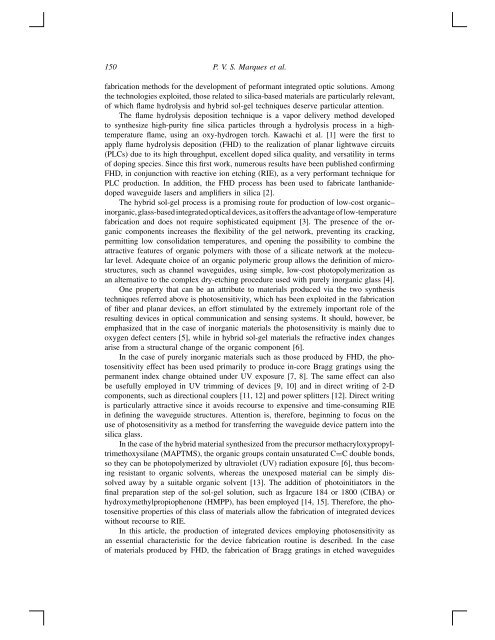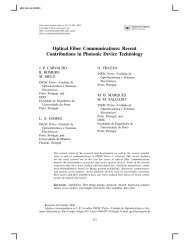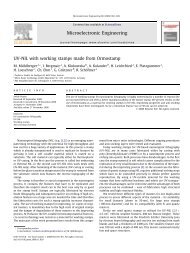Photosensitive Materials for Integrated Optic ... - ResearchGate
Photosensitive Materials for Integrated Optic ... - ResearchGate
Photosensitive Materials for Integrated Optic ... - ResearchGate
You also want an ePaper? Increase the reach of your titles
YUMPU automatically turns print PDFs into web optimized ePapers that Google loves.
150 P. V. S. Marques et al.<br />
fabrication methods <strong>for</strong> the development of pe<strong>for</strong>mant integrated optic solutions. Among<br />
the technologies exploited, those related to silica-based materials are particularly relevant,<br />
of which flame hydrolysis and hybrid sol-gel techniques deserve particular attention.<br />
The flame hydrolysis deposition technique is a vapor delivery method developed<br />
to synthesize high-purity fine silica particles through a hydrolysis process in a hightemperature<br />
flame, using an oxy-hydrogen torch. Kawachi et al. [1] were the first to<br />
apply flame hydrolysis deposition (FHD) to the realization of planar lightwave circuits<br />
(PLCs) due to its high throughput, excellent doped silica quality, and versatility in terms<br />
of doping species. Since this first work, numerous results have been published confirming<br />
FHD, in conjunction with reactive ion etching (RIE), as a very per<strong>for</strong>mant technique <strong>for</strong><br />
PLC production. In addition, the FHD process has been used to fabricate lanthanidedoped<br />
waveguide lasers and amplifiers in silica [2].<br />
The hybrid sol-gel process is a promising route <strong>for</strong> production of low-cost organic–<br />
inorganic,glass-basedintegratedopticaldevices,asitofferstheadvantageoflow-temperature<br />
fabrication and does not require sophisticated equipment [3]. The presence of the organic<br />
components increases the flexibility of the gel network, preventing its cracking,<br />
permitting low consolidation temperatures, and opening the possibility to combine the<br />
attractive features of organic polymers with those of a silicate network at the molecular<br />
level. Adequate choice of an organic polymeric group allows the definition of microstructures,<br />
such as channel waveguides, using simple, low-cost photopolymerization as<br />
an alternative to the complex dry-etching procedure used with purely inorganic glass [4].<br />
One property that can be an attribute to materials produced via the two synthesis<br />
techniques referred above is photosensitivity, which has been exploited in the fabrication<br />
of fiber and planar devices, an ef<strong>for</strong>t stimulated by the extremely important role of the<br />
resulting devices in optical communication and sensing systems. It should, however, be<br />
emphasized that in the case of inorganic materials the photosensitivity is mainly due to<br />
oxygen defect centers [5], while in hybrid sol-gel materials the refractive index changes<br />
arise from a structural change of the organic component [6].<br />
In the case of purely inorganic materials such as those produced by FHD, the photosensitivity<br />
effect has been used primarily to produce in-core Bragg gratings using the<br />
permanent index change obtained under UV exposure [7, 8]. The same effect can also<br />
be usefully employed in UV trimming of devices [9, 10] and in direct writing of 2-D<br />
components, such as directional couplers [11, 12] and power splitters [12]. Direct writing<br />
is particularly attractive since it avoids recourse to expensive and time-consuming RIE<br />
in defining the waveguide structures. Attention is, there<strong>for</strong>e, beginning to focus on the<br />
use of photosensitivity as a method <strong>for</strong> transferring the waveguide device pattern into the<br />
silica glass.<br />
In the case of the hybrid material synthesized from the precursor methacryloxypropyltrimethoxysilane<br />
(MAPTMS), the organic groups contain unsaturated C=C double bonds,<br />
so they can be photopolymerized by ultraviolet (UV) radiation exposure [6], thus becoming<br />
resistant to organic solvents, whereas the unexposed material can be simply dissolved<br />
away by a suitable organic solvent [13]. The addition of photoinitiators in the<br />
final preparation step of the sol-gel solution, such as Irgacure 184 or 1800 (CIBA) or<br />
hydroxymethylpropiophenone (HMPP), has been employed [14, 15]. There<strong>for</strong>e, the photosensitive<br />
properties of this class of materials allow the fabrication of integrated devices<br />
without recourse to RIE.<br />
In this article, the production of integrated devices employing photosensitivity as<br />
an essential characteristic <strong>for</strong> the device fabrication routine is described. In the case<br />
of materials produced by FHD, the fabrication of Bragg gratings in etched waveguides





